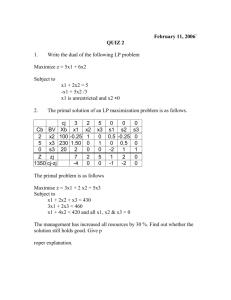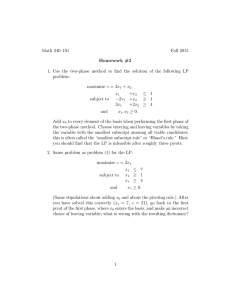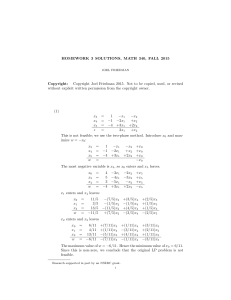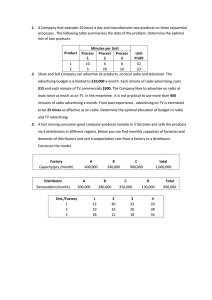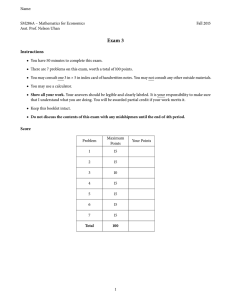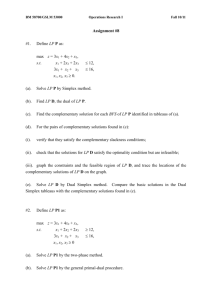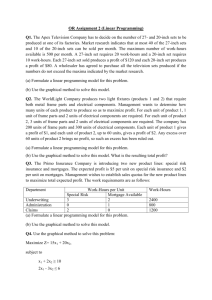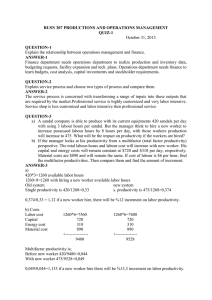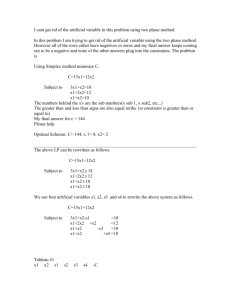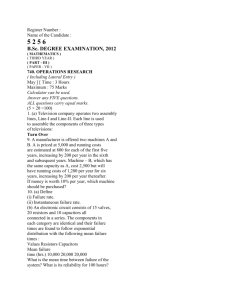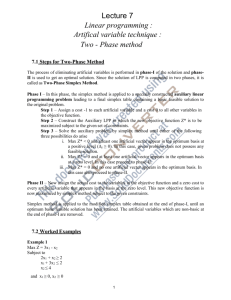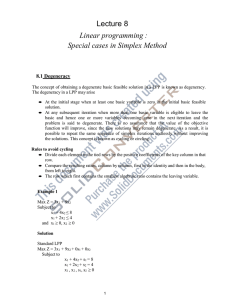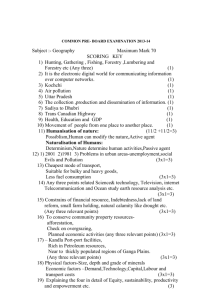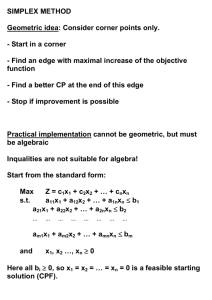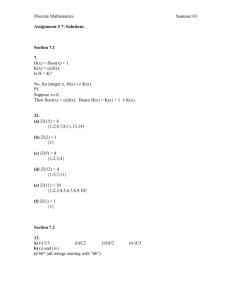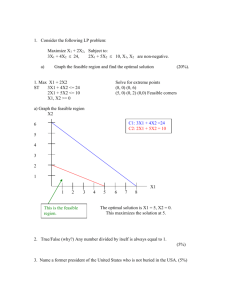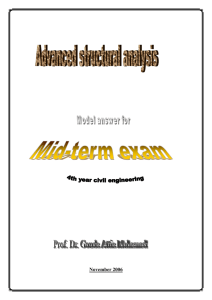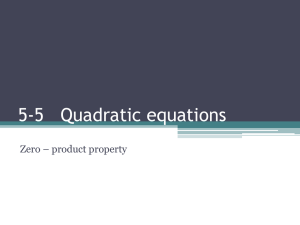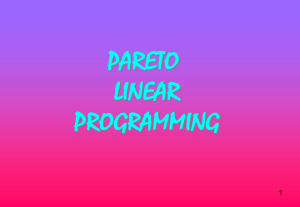Linear programming : Artificial variable technique
advertisement
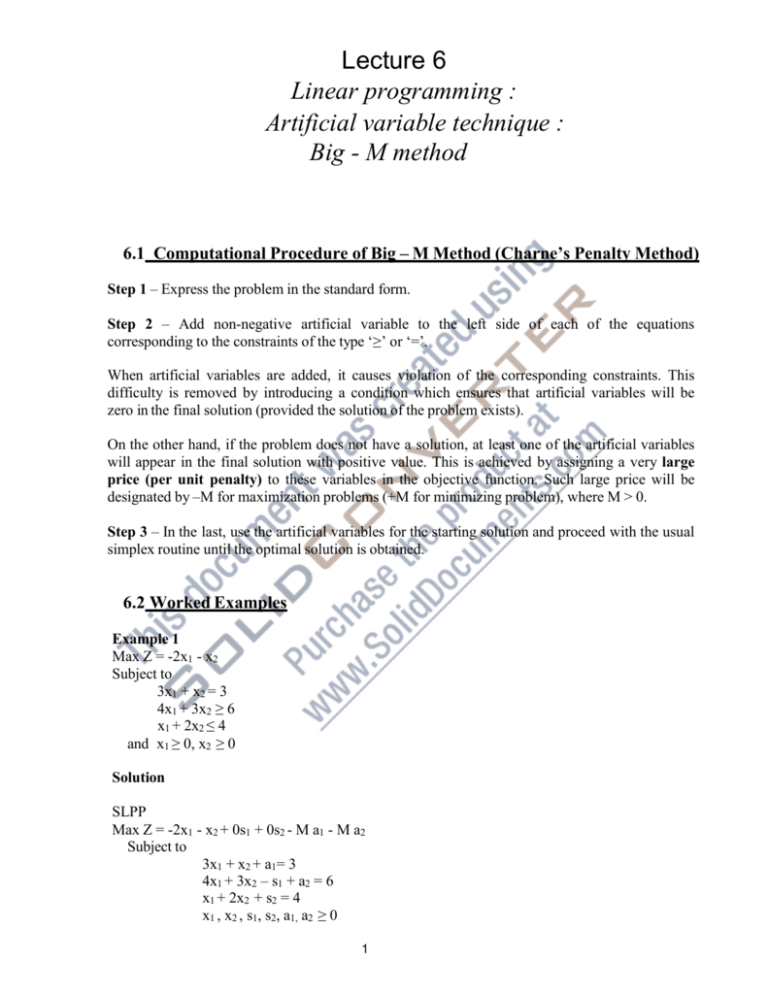
Lecture 6 Linear programming : Artificial variable technique : Big - M method 6.1 Computational Procedure of Big – M Method (Charne’s Penalty Method) Step 1 – Express the problem in the standard form. Step 2 – Add non-negative artificial variable to the left side of each of the equations corresponding to the constraints of the type ‘≥’ or ‘=’. When artificial variables are added, it causes violation of the corresponding constraints. This difficulty is removed by introducing a condition which ensures that artificial variables will be zero in the final solution (provided the solution of the problem exists). On the other hand, if the problem does not have a solution, at least one of the artificial variables will appear in the final solution with positive value. This is achieved by assigning a very large price (per unit penalty) to these variables in the objective function. Such large price will be designated by –M for maximization problems (+M for minimizing problem), where M > 0. Step 3 – In the last, use the artificial variables for the starting solution and proceed with the usual simplex routine until the optimal solution is obtained. 6.2 Worked Examples Example 1 Max Z = -2x1 - x2 Subject to 3x1 + x2 = 3 4x1 + 3x2 ≥ 6 x1 + 2x2 ≤ 4 and x1 ≥ 0, x2 ≥ 0 Solution SLPP Max Z = -2x1 - x2 + 0s1 + 0s2 - M a1 - M a2 Subject to 3x1 + x2 + a1= 3 4x1 + 3x2 – s1 + a2 = 6 x1 + 2x2 + s2 = 4 x1 , x2 , s1, s2, a1, a2 ≥ 0 1 Basic Variables a1 a2 s2 x1 a2 s2 Cj → -2 -1 0 0 -M -M CB XB X1 X2 S1 S2 A1 A2 -M -M 0 3 6 4 3 4 1 ↑ 2 – 7M 1 0 0 1 3 2 0 -1 0 0 0 1 1 0 0 0 1 0 1 – 4M 1/3 5/3 5/3 0 M 0 -1 0 0 0 0 0 0 1 ←Δj 1/1/3 =3 6/5/3 =1.2→ 4/5/3=1.8 1 0 X 0 0 X 0 ←Δj Z = -9M -2 1 -M 2 0 3 Z = -2 – 2M x1 x2 s2 -2 -1 0 3/5 6/5 1 Z = -12/5 0 X X 1 0 0 0 1 0 1/5 -3/5 1 0 0 1 X X X X X X 0 0 1/5 0 X X Since all Δj ≥ 0, optimal basic feasible solution is obtained Therefore the solution is Max Z = -12/5, x1 = 3/5, x2 = 6/5 Example 2 Max Z = 3x1 - x2 Subject to 2x1 + x2 ≥ 2 x1 + 3x2 ≤ 3 x2 ≤ 4 and x1 ≥ 0, x2 ≥ 0 Solution SLPP Max Z = 3x1 - x2 + 0s1 + 0s2 + 0s3 - M a1 Subject to 2x1 + x2 – s1+ a1= 2 x1 + 3x2 + s2 = 3 x2 + s3 = 4 x1 , x2 , s1, s2, s3, a1 ≥ 0 2 Min ratio XB /Xk 3 /3 = 1→ 6 / 4 =1.5 4/1=4 Basic Variables a1 s2 s3 x1 s2 s3 Cj → 3 -1 0 0 0 -M CB XB X1 X2 S1 S2 S3 A1 -M 0 0 2 3 4 2 1 0 ↑ -2M-3 1 0 0 1 3 1 -1 0 0 0 1 0 0 0 1 1 0 0 -M+1 1/2 5/2 1 0 0 1 0 0 0 0 1 0 0 1 0 0 5/2 3 5 1 M -1/2 1/2 0 ↑ -3/2 0 1 0 0 1/2 2 0 0 0 0 1 X X X X 0 10 0 3/2 0 X Z = -2M 3 1 0 2 0 4 Z=3 x1 s1 s3 3 0 0 3 4 4 Z=9 Since all Δj ≥ 0, optimal basic feasible solution is obtained Therefore the solution is Max Z = 9, x1 = 3, x2 = 0 3 X X X Min ratio XB /Xk 2 / 2 = 1→ 3/1=3 ←Δj 2/1/2 = 4→ ←Δj Example 3 Max Z =3x1 + 2x2 + x3 Subject to 2x1 + x2 + x3 = 12 3x1 + 4x2 = 11 and x1 is unrestricted x2 ≥ 0, x3 ≥ 0 Solution SLPP Max Z = 3(x1' - x1'') + 2x2 + x3 - M a1 - M a2 Subject to 2(x1' - x1'') + x2 + x3 + a1= 12 3(x1' - x1'') + 4x2 + a2 = 11 x1', x1'', x2 , x3, a1, a2 ≥ 0 Max Z = 3x1' - 3x1'' + 2x2 + x3 - M a1 - M a2 Subject to 2x1' - 2x1'' + x2 + x3 + a1= 12 3x1' - 3x1'' + 4x2 + a2 = 11 x1', x1'', x2 , x3, a1, a2 ≥ 0 Basic Variables a1 a2 a1 x1' x3 x1' Cj → 3 -3 2 1 -M -M CB XB X1' X1'' X2 X3 A1 A2 -M -M 12 11 2 3 ↑ -5M-3 0 1 -2 -3 1 4 1 0 1 0 0 1 5M+3 0 -1 -5M-2 -5/3 4/3 0 1 0 0 X X ←Δj 14/3/1 = 14/3→ - 0 0 1 -6 0 -1 5/3M+1 -5/3 4/3 -M-1 1 0 ↑ -M-1 1 0 0 X ←Δj X X X X 0 0 1/3 0 X X Z = -23M -M 14/3 3 11/3 1 3 14/3 11/3 Z = 47/3 Since all Δj ≥ 0, optimal basic feasible solution is obtained x1' = 11/3, x1'' = 0 x1 = x1' - x1'' = 11/3 – 0 = 11/3 Therefore the solution is Max Z = 47/3, x1 = 11/3, x2 = 0, x3 = 14/3 4 Min ratio XB /Xk 12 /2 = 6 11/3 =3.6→
